Because of the Plat_Forms competition, we released special versions of JVx, WebUI and OnlineHelp. All releases are available from our project page.
We implemented some amazing new features for JVx and WebUI.
Check out the changelogs for details.
Some tags:
- Simple charting
- Default layouts
- Global metadata caching (server-side)
- Modal frames in WebUI
- Table handling in WebUI
It is available from the project page.
What’s New?
The complete list of changes can be found here.
- Default Database (CoC)It is now possible to configure multiple db datasources via config.xml
<?xml version="1.0" encoding="UTF-8"?>
<application>
<securitymanager>
<class>com.sibvisions.rad.server.security.DBSecurityManager</class>
</securitymanager>
<datasource>
<db name="default">
<url>jdbc:oracle:thin:@localhost:1521:mydb</url>
<username>user</username>
<password>password</password>
</db>
</datasource>
</application>
If the DBSecurityManager does not define a specific datasource, the datasource with the name "default" is used.
- Quoting in DBAccessDBAccess supports case sensitive database access. To enable the feature, call
on your DBAccess instance.
- Custom SessionManager and ObjectProviderIt was possible to use a custom ObjectProvider but it was not possible to extend the DefaultObjectProvider. Now this limit is gone. Additional it is now possible to use a custom SessionManager and extend the DefaultSessionManager.
Configure the objects in your server config.xml like this:
<server>
<sessionmanager>com.sibvisions.AnotherSessionManager</sessionmanager>
<objectprovider>com.sibvisions.AnotherObjectProvider</objectprovider>
<server>
- Server Side TriggersOur DataBooks now supports specific events like before insert or after delete. The server side storage did not have this events, so you had to overwrite the data manipulation methods to call your business logic or to change the default behaviour. That was not very cool.
We have implemented a very powerful feature, with which you have full control of your data sent to the data tier. Do you know database triggers?
Now you have the same power in your storages.
A short example:
public void getUsers
()
{
DBStorage dbsUsers
= new DBStorage
();
dbsUsers.
setDBAccess(getDBAccess
());
dbsUsers.
setFromClause("V_USER_USERS");
dbsUsers.
setWritebackTable("USERS");
dbsUsers.
open();
dbsUsers.eventBeforeInsert().addListener(this, "doEncryptPwd");
dbsUsers.eventBeforeUpdate().addListener(this, "doEncryptPwd");
}
public void doEncryptPwd(StorageEvent pEvent)
{
IBean bn = pEvent.getNew();
bn.put("PASSWORD", AbstractSecurityManager.getEncryptedPassword(
SessionContext.getCurrentSessionConfig(),
(String)bn.get("PASSWORD")));
pEvent.setNew(bn);
}
Use the event handling as usual.
- Flat POJO support for StoragesInstead of using the dynamic property access via IBean, it is possible to work with POJOs:
public void doEncryptPwd
(StorageEvent pEvent
)
{
User user
= pEvent.
getNew(User.
class);
user.setPassword(AbstractSecurityManager.getEncryptedPassword(
SessionContext.getCurrentSessionConfig(),
user.getPassword()));
pEvent.setNew(user);
}
You can work with every useful POJO because the storage mapps only available properties to the POJO.
- Useful bugfixes
We look forward to your reviews 
Check out our new JVx version. It is available from the project page.
What's in the current beta?
The complete list of changes can be found here.
Some features, however, at this point:
- Introduced DBCredentials and DataSourceHandlerIt is now possible to configure multiple db datasources via config.xml
<?xml version="1.0" encoding="UTF-8"?>
<application>
<securitymanager>
<class>com.sibvisions.rad.server.security.DBSecurityManager</class>
<database datasource="mydb" />
</securitymanager>
<datasource>
<db name="mydb">
<url>jdbc:oracle:thin:@localhost:1521:mydb</url>
<username>user</username>
<password>password</password>
</db>
<db name="masterdb">
<url>jdbc:derby://localhost:1527/masterdb</url>
<username>master</username>
<password>master</password>
</db>
</datasource>
</application>
and use the configured security manager connection in the Session:
IConfiguration config
= SessionContext.
getCurrentSessionConfig();
dba = DBAccess.getDBAccess(DBSecurityManager.getCredentials(config));
dba.open();
or any connection, by name:
IConfiguration config
= SessionContext.
getCurrentSessionConfig();
DBCredentials cred = DataSourceHandler.createDBCredentials(config, "masterdb");
dba = DBAccess.getDBAccess(cred);
dba.open();
It is still possible to use the old configuration format:
<?xml version="1.0" encoding="UTF-8"?>
<application>
<securitymanager>
<class>com.sibvisions.rad.server.security.DBSecurityManager</class>
<database>
<driver>org.hsqldb.jdbcDriver</driver>
<url>jdbc:hsqldb:hsql://localhost/demodb</url>
<username>sa</username>
<password></password>
</database>
</securitymanager>
You can create DBCredentials or read the config programatically, as it was with JVx 0.8.
- Introduced AbstractCachedStorageThe AbstractCachedStorage is the new base class for all IStorage or ICachedStorage implementations. It implements the metadata caching and offers simple export functionality. With this class it is easy to develop new storages.
- Introduced AbstractMemStorageThe AbstractMemStorage extends the AbstractCachedStorage and offers a MemDataBook on the server-side. With this class it is very simple to create storages with data kept in memory. You don't need a special backend, e.g. you can use a List to fill the storage. Our TwitterStorage uses this storage.
- DBAccess supports pre-configured java.sql.ConnectionCreate a DBAccess instance with a pre-configured connection, e.g.
Connection con
= getJNDIConnection
();
DBAccess.getDBAccess(con)
- XmlNode performance tuningOur XmlNode allows XML access with following syntax:
XmlWorker xmw = new XmlWorker();
xmnRead = xmw.read(new FileInputStream("example.xml"));
xmnRead.setNode("/archive/element(1)/user", "xml");
xmnRead.setNode("/archive/new/element", "car");
The class offers powerful and simple XML handling - check it out!
- Bugfixes and Test cases
We look forward to your reviews 
We described all DataBook events and row states with some articles in our Forum. The events and states are very important if you need special data/row handling on client side e.g. ask the user before delete record(s).
The articles includes flow charts and practical examples. If anyone has questions, just post to the forum.
Direct links to the events and states.
We have a lot of useful features in JVx. It is very easy to develop multi tier applications, two tier applications or simple desktop applications - started as RIA, Web or Standalone application.
Every tier is technology independent and does not require third party frameworks. We can use every useful framework to create business logic.
But we don't have a lot of connectors out-of-the box (at the moment). There are a lot of technologies out there, e.g. NOSQL, Cloud services, Facebook, Twitter, YouTube, REST, ...
Not all technologies are useful for business apllications, but it is a lot of fun to work with new technologies 
We spent some hours to develop a simple Twitter client (rather a connector) to read/delete/insert Tweets. The result can be seen here:
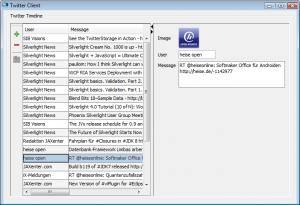
Twitter client with JVx
What we did?
- Created a new Storage, called TwitterStorage
- extended AbstractMemStorage
- Implemented loadData, insert, delete and getRowDefinition
- used twitter4j
After 290 lines of code we were finished. The standard RemoteDataBook works perfect with the new Storage (full support for filtering, sorting, master-detail relations).
JVx 0.8 ist out now!
We put much time and work into the new release. It contains almost 100 improvements!
But before we go into the details, it should be mentioned that JVx is now hosted on SourceForge. This step was particularly important to us, in order to be able to develop together with our Community.
Our Forum contains detailed instructions for working together.
We appreciate any help.
Download JVx 0.8 here
What's new?
- API changes
- We removed set/getTableColumnNames, set/getTreeColumnNames, set/getEditorColumnNames and introduced ColumnView. Now it is possible to set a column view per UI control e.g.: ITable, ITree, IEditor, null (ALL)
Old:
rdbInvoice.getRowDefinition().
setTableColumnNames(new String [] { "POS", "PRICE"});
New:
rdbInvoice.getRowDefinition().
setColumnView(null, new ColumnView("POS", "PRICE"));
- DBAccess has now a static method, setAutomaticLinkColumnNameTranslation, to translate the automatic link column names into a user-defined name.Default:
tmpAutoLinkColumnNames.put("*_id", "*");
tmpAutoLinkColumnNames.put("*_ID", "*");
- Changed, automatic, visible column detection from case insensitive to case sensitive, for compatibility reasons!Old:
setDefaultIgnoredColumnNames("*_ID");
New:
setDefaultIgnoredColumnNames("*_ID", "*_id");
Default:
"*ID", "*id", "*_ID", "*_id", "*_INTERN", "*_intern"
- Renamed countRows to getEstimatedRowCount in IStorage
- MetaData handlingReduced client/server requests,
Reduced creation loops on server side,
Caching for sub storages,
Fixed Nullable column detection,
Client Cache roles,
Label detection,
Split Client and Server MetaData usage
- SerializerUniversalSerializer is now the standard serializer,
Support for async serialization with new TypeCache,
Bean packages unified,
New init method for ISerializer,
The serializer name is now included in the connection properties
- JNDI supportServer is now available via JNDI or Singleton
- DB supportHSQLDB driver is now registered,
HSQLDB locking mechanism fixed,
Derby locking support,
close open statements,
Check constraint detection with 'OR', 'AND', 'IN',
Automatic Link Column Name detection works now DB independent,
Fetch optimization (reduced method calls),
BigDecimal DataType contains always a BigDecimal - DB independent
- SecurityDifferend Password algorithms (SecureHash),
Automatic Security detection of lifecycle objects,
XmlSecurityManager now supports more than 1 User
- Smaller changes and BugfixesAll details are documented in our Support System or the ChangeLog
The source code of JVx is now hosted on SourceForge!
As a little bonus, we gave following packages in the repository:
- JVx Core
- JVx Android AddOns
- JVx Swing UI
- JVx QTJambi UI
- JVx Web UI
- JVx Flex client and server (proof of concept)
And finally, we decided to release the complete source code of our JVx .NET AddOns. The source code was not yet available and is still in development.
We look forward for many helping hands!
JVx defines a technology independent User Interface, with Interfaces. Each technology has to implement this interfaces for its components and controls, to be compatible with JVx. We have implemented all this interfaces for Swing.
In addition we have created some swing components with special features for business applications. This components are simple extensions to existing swing components and are supported from any Look and Feel. They can be used in any swing application with or without the whole JVx framework.
We will show here some of this components:
- DesktopPane with tab or frame mode
Switch between tab and frame view, Closable tabs (works with java 1.5 and is LaF independent), Drag and Drop Tabs, Tab navigation with keyboard, Modal frames, Background image.
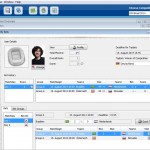 Frame mode |
|
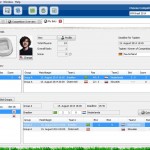 Tab mode |
|
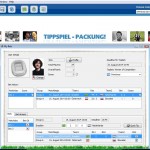 Desktop Background |
|
- ComboBoxes with user-defined popup components
A base implementation of a ComboBox called ComboBase. With this combo you can build your own ComboBox for e.g. input first and last name in separate fields. We implemented a date chooser and a table selector (header is:
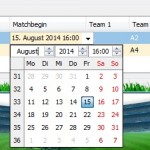 Date Combo |
|
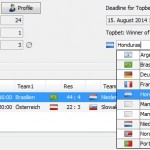 Table Combo |
|
- Table with load-on-demand model and ready-to-use cell editors/renderers
A table which uses an IDataBook implementation as model (e.g. MemDataBook) and shows cell editors and renderers dependent of the cell data types, e.g. a table with image renderer and multiple choice editor/renderer
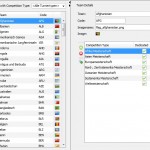 Table with renderer and editor |
|
| Following editors/renderer are available: Text, Number (only numbers are allowed), Date, Multiple Choice, Image |
|
- Button
A standard button and a toggle button with support for mouse-over borders.
- Icon
A special icon which supports image stretching and alignment.
Our implementation includes not only Swing components. It also contains some useful layouts:
- FormLayout
Anchor based layouting. Supports margins, stretching, gaps, ... It is designed for simple and complex forms.
- BorderLayout
Supports margins.
- SequenceLayout
Supports component stretching, component orientation, intelligent wrapping.
If you are interested in JVx, leave a comment or join our community.
You are welcome!
Seit wenigen Augenblicken steht die erste Beta Release von unserer QT Jambi UI Implementierung zum Download bereit. Dieses Release enthält sowohl Erweiterungen zu den Standard Widgets als auch die Implementierung von javax.rad.ui.
Zu den Erweiterungen zählen unter anderem:
- Border Layout
Das gewohnte Border Layout mit der Ausrichtung NORD, SÜD, WEST, OST, ZENTRIERT
- Form Layout
Das Anker orientierte Layout ist eine Portierung aus dem Swing UI und ermöglicht die Erstellung von komplexen Layouts ohne Schachtelung.
- Sequence Layout
Im Gegensatz zu einem Flow Layout ermöglicht dieses Layout die Komponenten zu stretchen, die vertikale bzw. horizontale Anordnung der Komponenten sowie die Ausrichtung der Komponenten zu beeinflussen.
- Zell Editoren
Die üblichen Editoren für Datum, Passwort, Zahlen und Text.
- Anpassbare Combos
Im Normalfall ist es schwierig eine Combo Box mit einem speziellen Layout und/oder benutzerdefinierten Komponenten zu verändern. Die Bibliothek enthält bereits eine Basis Combo Box, mit der eine Combo Box beliebig gestaltet werden kann.
- Desktop und (modale) Internal Frames
Die Desktop Implementierung ermöglicht Frames die wahlweise modal angezeigt werden. Weiters wurde das Event handling von Java im Bezug auf Internal Frames umgesetzt.
Die Widgets sind unabhängig von JVx und können auch in Applikationen, die nicht auf JVx aufsetzen, integriert werden. Bei der Umsetzung wurde auf höchste Kompatibilität geachtet.
Die Showcase Anwendung steht zum Testen bereit.
Die Implementierung ist über unsere Download Seite verfügbar!
Die Web UI Implementierung von JVx wurde bereits in früheren Postings vorgestellt. Kurz zusammengefasst handelt es sich dabei um die Möglichkeit, eine bereits entwickelte Applikation als HTML/Ajax Anwendung zu starten, ohne auch nur eine Zeile Source Code zu verändern. Die vormals als RIA gestartete Anwendung wird einfach (zusätzlich) als Web Anwendung zur Verfügung gestellt z.B. für mobile Geräte.
Seit heute steht unsere Showcase Anwendung als Rich Internet Application und Web Application zur Verfügung. In beiden Fällen wird die selbe Applikation verwendet!
Überzeugen Sie sich von unserer Innovation und starten Sie die RIA und die Web Anwendung getrennt voneinander.
Selbstverständlich funktioniert unsere Web Anwendung auch auf mobilen Geräten wie dem iPad/iPhone oder einem Android Device wie dem HTC Desire. Die Anwendung wurde jedoch nicht für die Auflösung dieser Geräte optimiert. Das Ergebnis sollte aber auf alle Fälle beeindrucken:
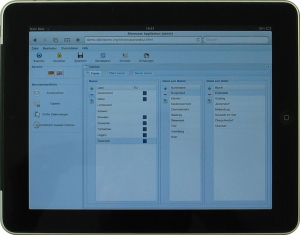 iPad Showcase |
|
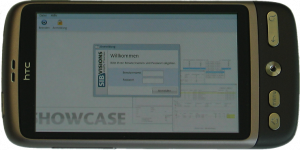 HTC Desire Showcase |










 RSS-Feed
RSS-Feed